
3S is the abbreviation for “Seiwa Scholars Society,” which consists of the past and current Inamori Research Grant recipients. The 3S has evolved since 1997 with the hope that the interactions among the various specialties of the 3S members can lead to the further development of the research of their own. In the series “Visiting 3S Researchers,” we interview researchers in 3S who are very active in a variety of fields. The sixth interview is with Dr. Hiroko Nishida (2017 Inamori Research Grant Recipient) from Kyushu University.
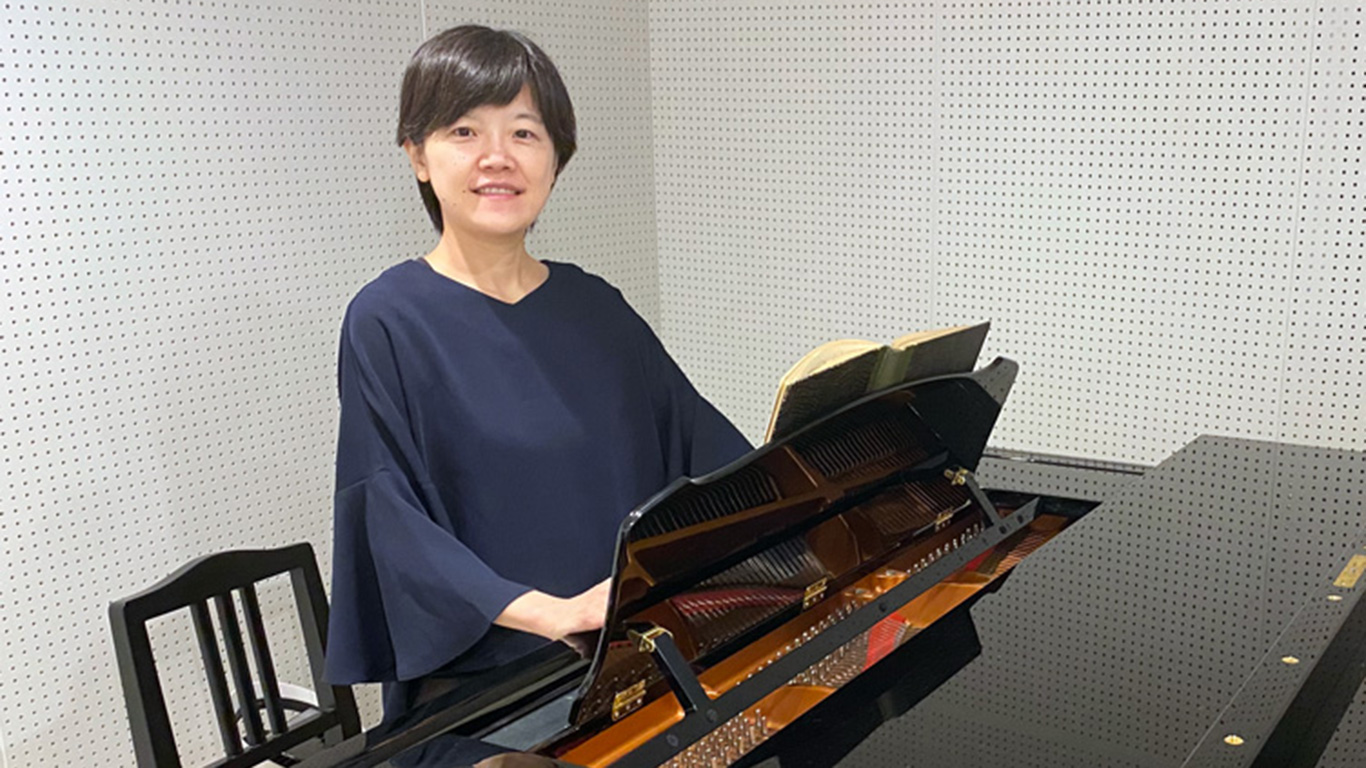
Musicology is an academic discipline that involves studying music from various perspectives. Music gives color to our daily lives, but what can academic research reveal about it? We talked with Dr. Nishida, who is seeking to broaden the audience base for music by incorporating techniques derived from literature, sociology, statistics and other fields of study into her research, and we asked her what she finds appealing about studying musicology.
── What are the attractive aspects of musicology as a field of study?
Dr. Nishida (title omitted below) I feel at times that the culture of researching music as an academic discipline has not really taken root in Japan. People even remark to me “music is there just to be enjoyed, nothing more; what’s the point of studying music academically?” But, that way of thinking, measuring music with just one yardstick, could lead to music being labeled as “non-essential.” Orchestra and art music are inherently premised on “intellect.” The creators of music do not mean for their works to be simply felt. I believe that, through studying how and against what social background a musical work has been composed, or by examining the structure of a composition, we can provide different perspectives of music besides just “listen and feel,” and that we can shed light on the appeal of music from various angles.
── Could you tell us about music theory, one of your specialties?
Nishida One approach to music theory is to pick out notes that are structurally important from a piece and analyze them. The term “theory” gives an impression that it is an established standard, by following which anyone can reproduce the same analysis. However, unlike in natural science, we don’t aim for reproducibility in music theorems; rather, we give more weight to the process of interpreting musical works using those theorems. Using music theory, we mainly explore the intention of a composer in creating a piece. That said, it is not only the composer’s intention that makes a highly complex work of music. Musical tones are bound by certain rules, such as the one that requires a chord that creates tension to be followed by tones that give a sense of release; so, when writing music, composers are subconsciously affected by this kind of musical “grammar.” Heinrich Schenker, a music theorist and initiator of the well-known “Schenkerian Theory,” focused on such phenomena and developed the idea that “a work of music is an organism.”
── What did he mean by “music is an organism”?
Nishida In a musical work, there isn’t a single superfluous note, no matter how long the piece may be. Notes on the staves that seem detached and unrelated at first glance are, in fact, all connected in significance to each other. That was the gist of his concept. All of the cells in the body of a living creature, even those in the remotest parts of the body, exist and interact with each other for the purpose of sustaining life. Schenker thought that musical works are, or should be, similarly constructed organically and without anything extraneous or redundant.
The Schenkerian Theory and the analytical method based on it, known as “Schenkerian Analysis,” were developed and practiced mainly in the U.S. after World War II, and they still strongly influence today’s musical researchers and performers. But, what I found more interesting than the theory itself was Schenker’s thinking that formed the backdrop against which he constructed the theory. After delving into Schenker’s thinking and the process through which he developed the theory, I wrote and published a book entitled Heinrich Schenker’s Musical Thoughts.
── How did you approach your study of his thinking?
Nishida In addition to his published works, I read deeply into Schenker’s letters, diaries, and notes that he scribbled in the margins of his drafts. I tried to gather as many materials as I could lay my hands on, so that I would not end up having an arbitrary selection of convenient data. I not only collected materials directly related to Schenker but also looked into the writings of his contemporaries. Coming across someone in a different discipline or field of art who had made similar assertions or used the same words as did Schenker helped me to envisage the network of thinking, or should I say the cultural context of his time.
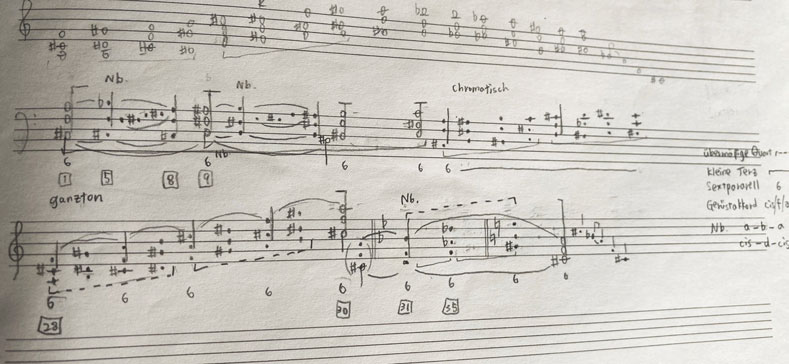
── What can you tell from the notes in the margin?
Nishida For example, one of his contemporaries in Vienna was the composer Schoenberg. The two men engaged in fierce debate, which we can see from historical materials. They not only exchanged letters but also intensively read each other’s books and wrote detailed counter-arguments on the pages of those books, such as “This is wrong” or “What I think is this.” It’s really astonishing how they could become so heated. I couldn’t help thinking: “Why couldn’t you guys just let both arguments stand and settle for that?”
The European culture of treating musical interpretation so seriously was totally new to me. I felt the urge to know more about it, which became the driving force for my research into Schenker’s thinking.
── Did you encounter any difficulties?
Nishida Schenker is barely studied in Japan. Even in the U.S., where his theory and analytical method are widely used as a tool, it was only recently that his thinking came into the spotlight. So, in my undergraduate days, my only options to gather materials were to go to Vienna or have copies sent to me. Before the COVID-19 pandemic, I used to visit Europe in the summer and gather up sets of materials. Furthermore, those documents are all written in German, and the old German cursive style at that, since Schenker lived from 1868 to 1935, which means you cannot read it so easily, even if you are familiar with the modern German language. I would often spend a whole day struggling to decipher just one sentence, deducing like “it’s positioned between A and C, so it must be that word.” But, perhaps I enjoyed these experiences more than I suffered them. There are certain things that you can understand only by being there and immersing yourself in local culture, and I felt it was worthwhile to spend a long time tackling those scripts.
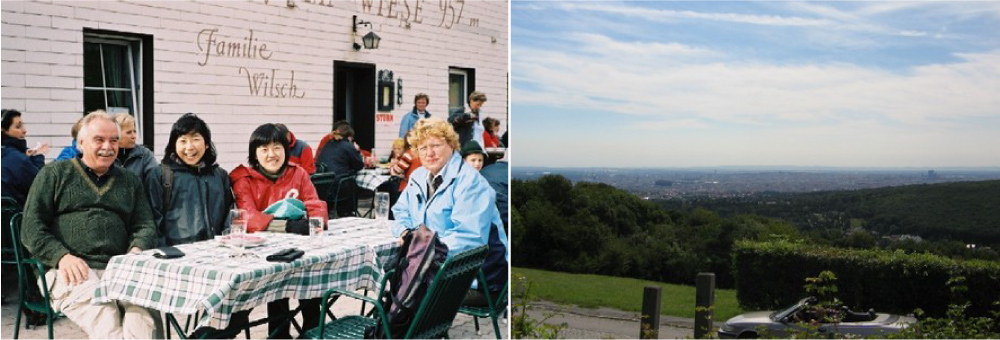
── In addition to studying music theory, you are also conducting research on communication in performance. They seem like totally different fields, so how do you see the connection between them?
Nishida A musical work does not start and end with the composer. It inherently needs to be performed in order to be delivered. A piece can sound radically different when it is played by another performer. So, especially in a group performance, it is important to coordinate the members’ expressive intentions. I am interested in the process of this coordination. In music theory studies, I focus on the process that a composer goes through when creating a piece, whereas in studying communication in performance, I pay attention to the process through which a performance is created. The two are intimately connected and differ only in perspective.
── How is communication in performance different from communication in other settings?
Nishida They frequently use metaphors when communicating. This is something that became clear as a result of my research. Music is an invisible phenomenon, so I suppose it cannot be put directly into words. Use of metaphors such as “let’s ascend melody like a roller coaster” or gestures that are puzzling at first sight to non-professionals seems to work more effectively.
── What methods do you use to study communication in performance?
Nishida I watch recordings of rehearsals and lessons, over and over again, and analyze them, taking notes using specialized software. We adopted an analytical method that had been used in sociology, through a collaboration with a specialist in communication studies. In my study of Schenker’s thinking, I utilized a method based on literary theory. I think my research projects tend to bring in methodology from other disciplines. I am interested to see what chemical reaction will happen if I work with someone from a different discipline. The Graduate School of Design, of which I am a member, comprises people from various fields, which puts me in the extremely fortunate position of having easy access to inputs from other disciplines.
For instance, I am currently engaged in a study on the social role of orchestras. I did one research project with specialists in the fields of cultural policy, business and economics, and statistics. An orchestra is a large group that is very costly to maintain and operate. Many of them receive public subsidies. Some people question the need for such groups in society. I, of course, believe in the value of orchestras, but merely arguing for their importance is not enough nowadays.
Today, people who listen to orchestras in music halls tend to be middle-aged and older. What will it be like in 30 years’ time? Managers of concert halls and orchestras must bear that prospect in mind. To give an example of my research, I examined what kinds of factors are affecting the programming of concerts in halls across Japan, using statistical analysis of musical pieces performed in the concerts. In an exhaustive examination of possibly relevant factors, such as the region’s population, average age, unemployment rate, frequency of concerts, and personnel costs, among others, some of the variables showed significant differences. I found, for example, that the programs in Tokyo differ distinctly from those in other regions. And, the organizers that host small-scale concerts (other than subscription concerts) more often can opt to present more adventurous pieces, in place of the well-known, in their programming for subscription concerts. Many of those findings may be just confirmation of what we have vaguely known already, or what has been sensed first-hand by people in the business. Nevertheless, I believe it is important that they are presented in statistical form and that the orchestras themselves work proactively to prove their value to society.
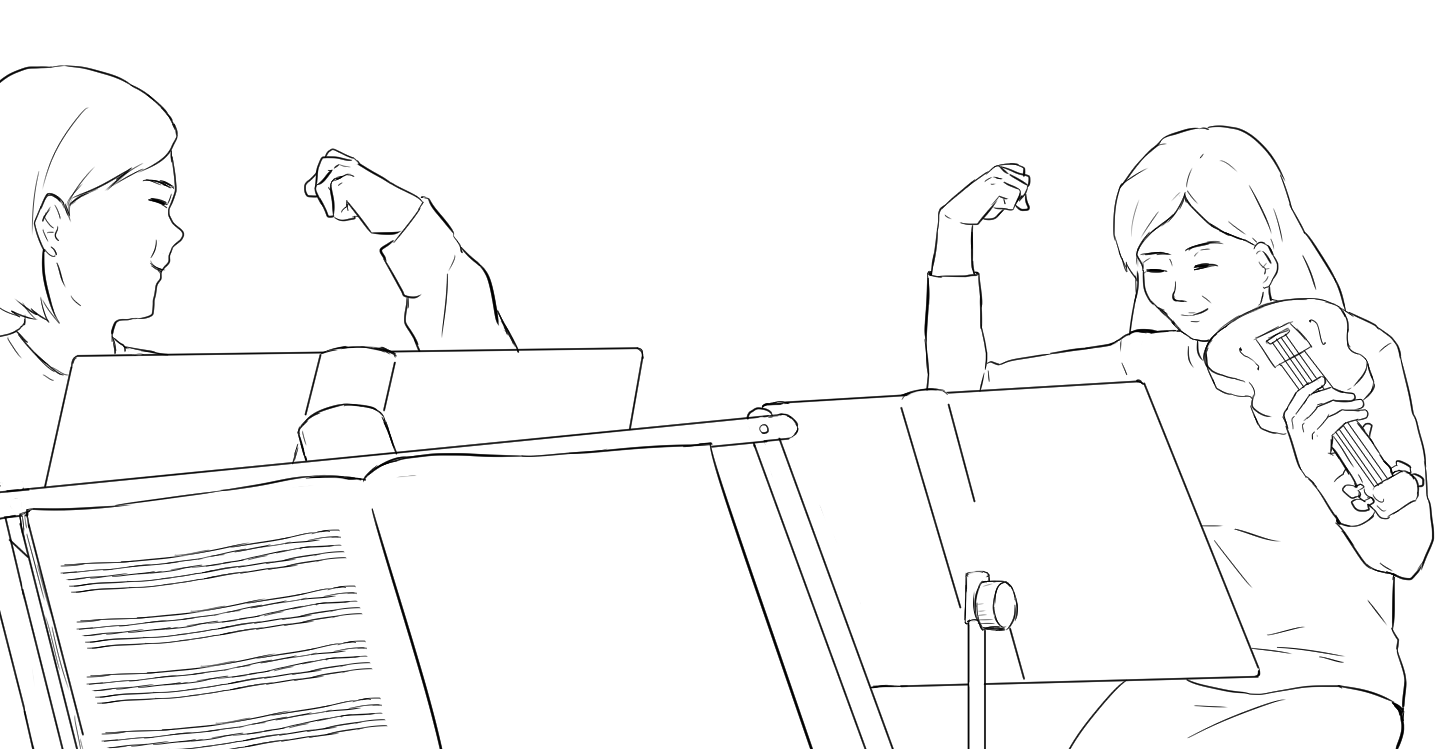
── You have done a number of collaborative studies with researchers in a range of fields, as well as with performers and other people in music. If you were to conduct another collaborative study, which field would you be interested in?
Nishida I am interested in the generation of music out of things that seem to have nothing to do with music. Some time ago, one student was doing a study on generating music from origami. In origami, as you go on folding, you get a lot of creases of different lengths and angles on the paper. By setting rules like, say, the length of a crease corresponds with the pitch of a tone and its angle corresponds with tone duration, you can create a variety of music from different origami pieces.
In fact, anything that is related to numbers can be converted into music, so I would be thrilled if I could come up with a new method of composition in that manner. So, my new research partner would probably be a specialist in physics, architecture, or some branch of mathematics related to geometry.
Thinking in terms of practicality, I would like to work with someone in the engineering field. There is an area of study that focuses on delivering linguistic and visual information in the form of sound. I am currently mentoring a student who is doing a study on converting the ups and downs of stock prices into sounds. Transforming something that is not originally music into auditory information is a subject of interest to me. There might be certain types of information that can be evaluated better when it is received by ear. It would be great if I could identify those and develop a tool that many will find convenient.
── You studied in the Department of Musicology, Faculty of Music. Why did you choose that path?
Nishida Around the time when I was in high school, music therapy, or the use of music in rehabilitation, was quite popular. That triggered my interest in learning how music affects human beings. I had been practicing piano since I was little, but not fervently enough to aspire to becoming a concert pianist, so I suppose I wanted to be involved in music in some other way.
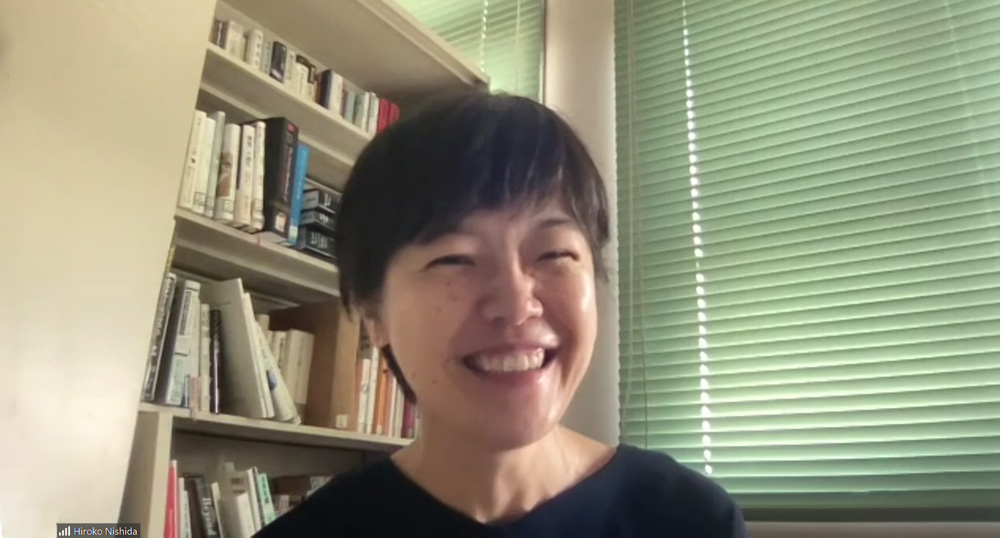
When I became a freshman, I wasn’t particularly interested in music theory. I was in a rock band and I loved music, but I only started listening to classical music for my course study after entering university. As I learned through analysis of musical works that there were pieces that had been logically composed, it suddenly became exciting. I enjoyed working to discern the intention of the composer and putting myself in his or her shoes. I cannot go so far as to create my own music, but understanding the mechanism of composition was truly a joyous experience.
I was also a great lover of mathematics, so I could have gone on to major in this direction, but I abandoned the idea because I realized that I didn’t have a good sense of math. However, music and numbers are very closely related. Historically, the elements of music have frequently been converted into numbers. When trying to theorize something we cannot see, it aids our understanding if we replace them with figures. So, in that sense, I guess I could say that what I like has become my job.
―Thank you very much.
| By My Side | Electronic piano During our online interview, Dr. Nishida was sitting at her desk in her office. There stood an electronic piano just behind her. “There is an electronic piano at home and one in my office, too, as I need a piano to check the notes on the score when I am doing my research or writing. I even have a keyboard app installed on my smartphone. I also play as I talk and let my students listen to the sounds and tunes during my online lectures.” 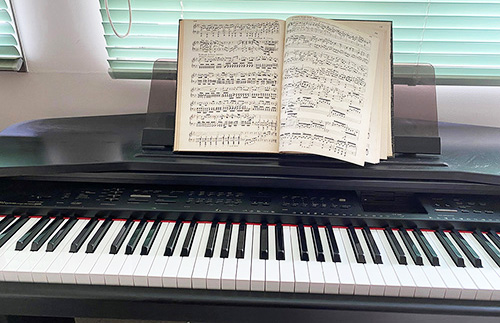 |
|---|---|
| This Book | “What is a Paradigm?—Kuhn’s Revolution in the History of Science” by Keiichi Noe (Book title translated) In this book, Mr. Noe, a philosopher of science, tells us about the history of science and what is fascinating about the philosophy of science as he discusses Thomas Kuhn, who introduced the concept of “paradigm.” “I was surprised to learn that scientific truth has changed over time through repeatedly being questioned and disproved, and I thought that I would like to do something similar in my musicology research. I also felt a deep respect for the author’s ability to explain complex and recondite matters in such a comprehensible and enjoyable way.”
|
Hiroko Nishida
Associate Professor, Graduate School of Design, Kyushu University. Dr. Nishida received her B.A. in Musicology from Tokyo University of the Arts, Faculty of Music and went on to earn her Ph.D. in the Graduate School of Music, during which time she studied music theory and analysis in a doctoral program at the University of Music and Performing Arts Vienna. After returning to Japan, she completed her Ph.D. in 2009 and earned a doctorate in musicology. She was appointed an assistant professor at the Graduate School of Design, Kyushu University in 2011, and has been in her current position since 2020. Dr. Nishida specializes in Western music theory and music aesthetics. She also analyzes what is happening during rehearsals or performances, and studies Japanese orchestras. Her published works include Heinrich Schenker’s Musical Thoughts: Beyond Music Analysis, Kyushu University Press.
Interview and original article by Izumi Kanchiku (team Pascal)
*The interview was conducted online.
Photos provided by Dr. Nishida
#01 Dr. Rie Umetsu
Observing Half-Metal Electrons as the Key to Device Innovations ─ Fundamental Power of Basic Research to Bridge Theory and Application ─

